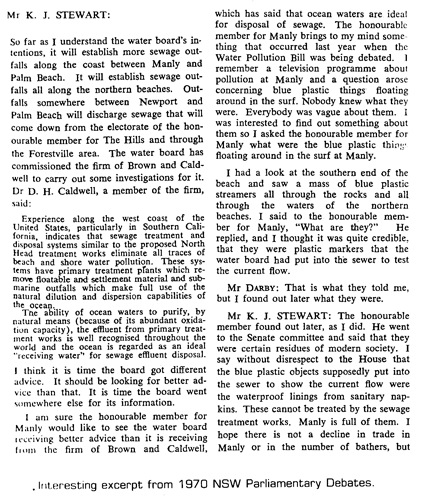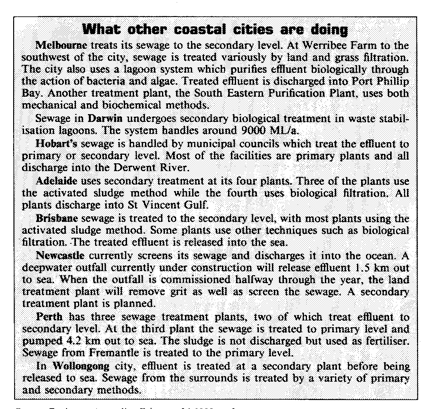
by Sharon Beder
first published by Allen & Unwin, Sydney, 1989
Introduction
Sewers seaward
Toothless watchdog
Toxic fish
Sewer-side surfing
Public relations battle
Events of 1989
Beyond Sydney
Conclusion
Bibliography
The primary treatment facilities promised in 1936 were finally constructed at Bondi and Malabar in the 1960s and 70s. They were also proposed for North Head.
In 1969 it was recognised by the Board that primary treatment alone would not be sufficient to prevent pollution on the beaches despite Water Board public claims to the contrary. The president of the Board thought it might be a good idea to build the extended outfall first at North Head because ‘Those people who were unhappy about sewage matter being dumped of the headland and washed onto the beaches might not be disturbed about material finding its way to these from about two miles out to sea’ (minutes, 19/2/69).

The Board brought Caldwell out from the United States to discuss the matter. Caldwell was adamant that full primary treatment facilities should be established before the deepwater outfall was constructed. If they were not, then floating matter, such as grease balls, pieces of rubber goods, and so on, would not be removed and these would rise to the surface and blow onto the beaches if the winds were onshore. Without primary treatment even fine screens would fail to remove the grease balls which would coalesce in the water after screening. Another problem with not providing primary treatment but only extended outfalls was that bacteria could not be effectively controlled. But the idea of building the extended outfall without primary treatment was reconsidered in 1977 after excavations were well advanced for a primary treatment plant. In an internal Water Board report on treatment options for North Head it was argued that both primary treatment with extended outfalls and reduced treatment with extended outfalls would meet the SPCC criteria. Furthermore, both options would still produce a better quality effluent than that produced by the primary treatment at Malabar (because the Malabar sewage contained more industrial wastes and its treatment plant was already overloaded and therefore not treating the sewage properly).
The North Head report claimed that the advantages of subjecting sewage to primary treatment over merely screening it and removing the grit and some of the grease disappeared if the solids, removed by primary treatment, were returned to the effluent before discharge. (This was what happened at the existing primary treatment plants at Bondi and Malabar, and what was planned for the future with the extended outfalls.) The North Head report even went so far as to say that the effect of treating the sludge before putting it back into the sewage discharge, as at Malabar, was to render the sludge more settleable, which would be a disadvantage in the sea because it would be more likely to settle out and accumulate on the ocean bottom where ocean currents were 1ow rather than to disperse. This says a 1ot for the treatment that the Board had already installed at Malabar and Bondi!
It is not surprising, then, that the report concluded that the extra cost of full primary treatment ($30 million in capital outlay and $5 million per year) could not be justified and that the reduced treatment option in conjunction with extended outfalls was recommended. The Board hesitated to take this step partly because it was worried about how it would look, given that so much money had been spent in excavating for the primary treatment plant. But it was not worried about getting approval for its new plans. The report stated: ‘Close liaison with senior officers of the SPCC has clearly established that the Commission favours the early provision of deepwater outfalls, at the expense of deferring or reducing onshore treatment facilities.’
To alleviate the grease removal problem, a minimal form of primary treatment was developed. Sewage would sit in tanks for fifteen minutes or so, giving time for some of the floating grease to rise to the surface and be skimmed off. This detention time was much shorter than for normal primary treatment and so the treatment was named ‘high-rate’ primary treatment. The name was such that the public was conned into thinking that it might be a superior type of primary treatment. The cost advantage of high-rate primary treatment was that a much smaller tank capacity was required and, since the suspended solids wouldn’t have time to settle out, there would be very little sludge to worry about.
Although high-rate primary treatment at North Head required official approval from the SPCC before it was constructed, Malabar and Bondi have in recent years been operating as de-facto high-rate primary treatment plants. For example, the Malabar treatment plant has only half the sedimentation tanks that would be required for full primary treatment and a confidential Water Board report stated in 1985 that the plant would be intentionally operated as a ‘pseudo-high-rate’ plant.
A comparison between the removal efficiencies of high-rate primary treatment and primary treatment shows that the Bondi and Malabar so-called primary treatment plants will continue to operate as high-rate primary treatment plants for many years to come.
Table 4.1 Comparison of removal efficiencies in sewage treatment

Source: Caldwell Connell, North Head EIS, 1979, p. 44; MWS&DB, Bondi EIS, 1979, p. 7
In the United States all municipal authorities have been required, since 1972, to install secondary treatment unless they can prove to the Federal Environmental Protection Agency (EPA) that the receiving waters would not be impaired and the discharge of toxic pollutants would not be higher than with secondary treatment. Sludge discharge into the ocean is banned. Waivers are extremely difficult to get. At the Hyperion outfall in California, which has often been cited by the Water Board as a model for Sydney’s deepwater outfalls, the EPA has required that secondary treatment be installed and fined Los Angeles City Council more than $600,000 for failing to do so quickly enough.
The aim of Sydney’s Water Board engineers seems to be to lead the world in new forms of minimal treatment. This requires a heavy dependence on the ocean to supply further treatment, but as surfers from POOO (People Opposed to Ocean Outfalls) have pointed out – ‘No-one wants to swim in a secondary treatment plant!’

Source: Engineers Australia, February 24 1989, p. 2